메트뮤지엄 한국실 25주년 특별전: Lineages: Korean Art at The Met 프리뷰: 박수근, 김환기, 장욱진 등
계보: 메트뮤지엄의 한국미술 Lineages: Korean Art at The Met
박수근, 김환기, 장욱진, 윤형근, 이우환, 서세옥, 서도호, 바이런 김...
2023년 11월 7일-2024년 10월 20일
메트로폴리탄뮤지엄 한국실
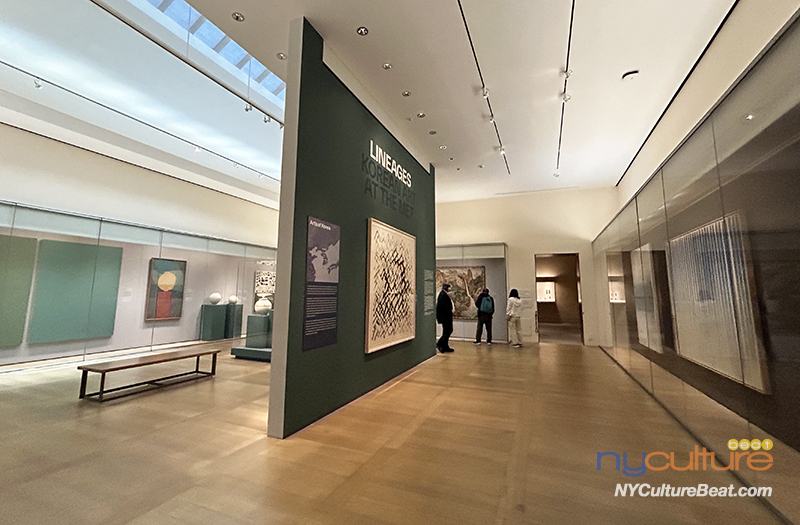
Lineages: Korean Art at The Met. Photo: Sukie Park/NYCultureBeat
The Met, 한국 갤러리 개설 25주년 기념전
(뉴욕, 2023년 10월 16일)—2023년 11월 7일 Metropolitan Museum of Art는 한국실 개설을 기념하여 'Lineages: Korean Art at The Met' 전시를 개최한다. 본 전시는 12세기부터 현재에 이르는 30여 점의 작품을 선보이며, 지난 25년간 The Met에서 수집한 작품 및 해외 기관으로부터 대여한 20세기 주요 작품이 함께 전시된다. 작품 다수는 전시 기간 중 교대로 전시될 예정이다. 이 전시는 선, 사물, 장소, 사람이라는 네 가지 주제를 통하여 굵직한 한국 예술사를 선보인다. 이 전시는 한국 문화체육관광부의 협조를 받았다.
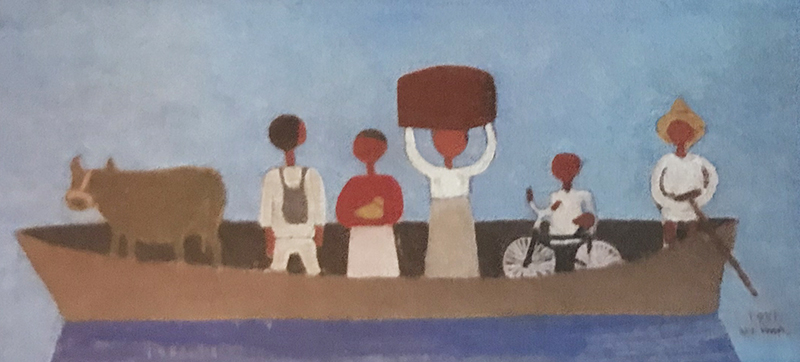
장욱진, 나룻배, 1951. 국립현대미술관 소장 이건희컬렉션
The Met에서 수집한 첫 한국 예술품은 악기 여덟 점으로, 1889년 Crosby Brown 컬렉션의 기증품 중 일부였다. 4년 후인 1893년에는 15세기 분청사기 인화 국화 무늬<경주장흥고>명대접를 입수했다. 이는 Hudson River School 화가인 Samuel Colman과 그의 아내 Ann Lawrence Colman (née Dunham)이 기증한 동양 도자기 245점 가운데 하나였다. The Met의 한국 미술 컬렉션은 1913년과 1930년 사이, 12세기 상감 칠기 상자와 고려시대(918-1392)의 국보급 불화 다섯 점 등 희귀 작품이 추가되는 등, 꾸준히 성장하였다.
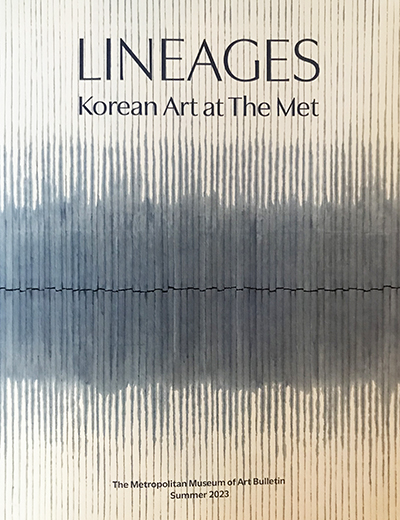
권영우, 무제, 1984. 리움미술관 소장
The Met는 1998년에 한국 미술 전문 갤러리를 설립하여 한국 미술 연구에 대한 의지를 보였다. 분청, 금강산, 신라 왕조(기원전 57년-서기 935)등의 새로운 미술 매체와 주제를 선구적인 전시와 출판물을 통해 전 세계 관객에게 소개하였다.
The Met의 한국국제교류재단 및 삼성문화재단 한국 미술 어소시에이트 큐레이터인 현수아(Eleanor Soo-ah Hyun) 씨는 “한국 미술 전시관이 가지는 의의는 매우 중요하다. 획기적인 전시를 통해 한국 미술을 선보일 뿐만 아니라, 수집과 대중 프로그램을 통해 한국 예술과 문화의 존재를 배양하고 확대하는 플랫폼을 제공한다. The Met는 이번 전시에서 한국 현대 미술을 선보이며 개발할 영역과 향후 추진 방향을 부각시킬 것이다.”라고 말했다.
전시 개요
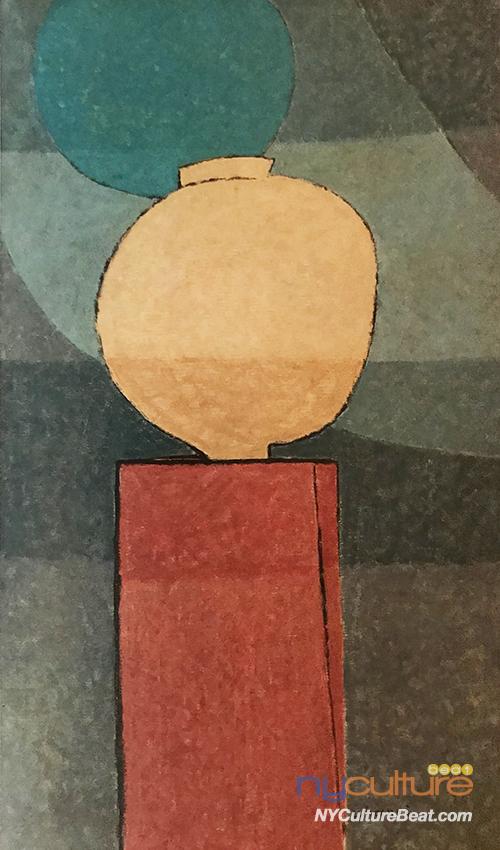
김환기, 달과 항아리, 1954. 리움미술관 소장
Lineages: Korean Art at The Met 전시는 동양화가 서세옥(1929-2020)의 수묵화 사람들(People)로 시작한다. 사람들(People)은 사람 인 한자의 반복으로 형성된 이미지로, 이번 전시의 네 가지 상호 연결된 주제인 선, 사물, 장소, 사람을 담고 있다. 첫 주제인 ‘선’은 한국 미술에서의 서예와 수묵화의 중요성과 함께 그 의미와 유산에 대한 현대 예술가들의 다양한 답변을 제시한다.
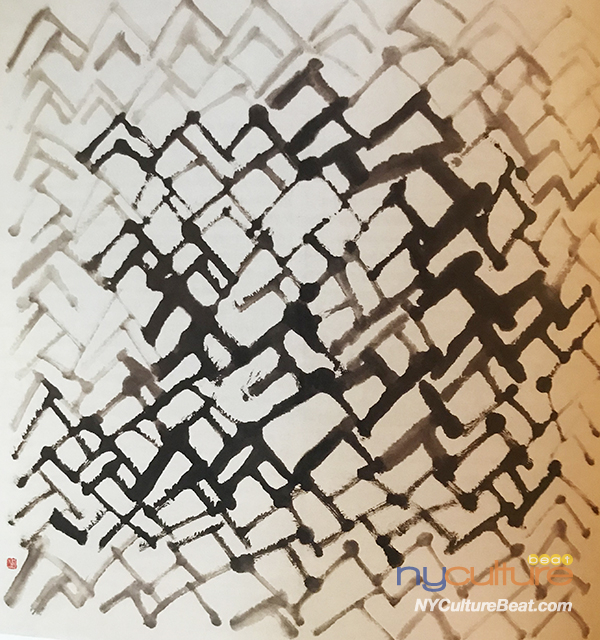
서세옥, 사람들, 1988. 국립현대미술관 소장
‘사물 ’은 전통 미술과 현대 미술 사이의 연결점을 작품을 통해서 탐구한다. 역사상 한국 도자기는 서구에서 지대한 주목을 받았으며, 수많은 서양 미술관에 소장되어 있다. The Met의 한국 소장품은 이 경향을 따른다.‘사물’이라는 주제 하에서 도자기는 현대 예술품과 짝을 이루어 함께 전시된다. 김환기 작가의 달과 항아리(Moon and Jar)부터 Byron Kim의 Goryeo Green Glaze #1과 Goryeo Green Glaze #2에 이르는 작품들은 고미술에서 영감을 얻을 뿐 아니라 이가 지니는 예술적 관례에 대해 의문을 제기한다.
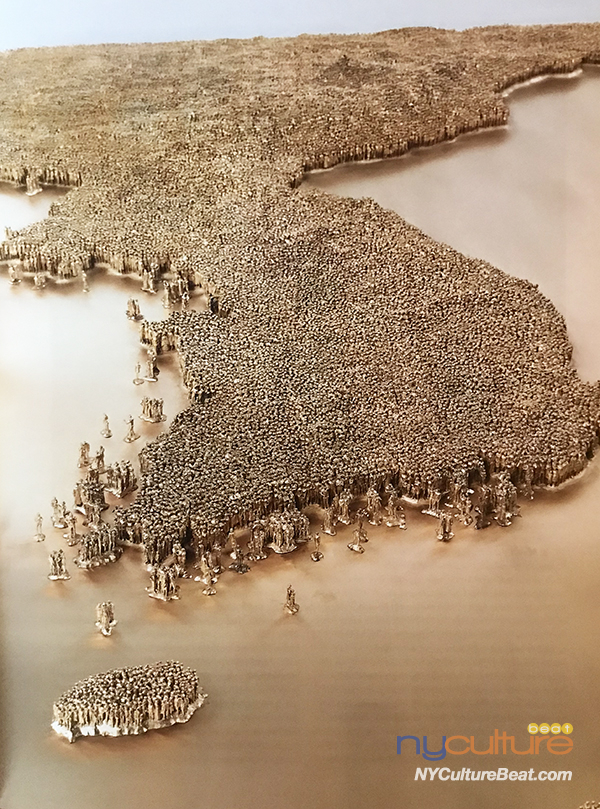
서도호, 우리나라, 리움미술관 소장
유산과 역사는 이번 전시의 세 번째 주제인 ‘장소’와 떼어놓고 논할 수 없다. 장소는 한국 미술, 특히 풍경화에 깊이 새겨 있으며, 소속감, 고향, 정체성의 개념과 연결된다. 20세기 한반도의 식민지화와 분단으로, 장소에 대한 이러한 개념에 분열, 강제 이동, 분리라는 의미가 더해졌으며, 이러한 복잡성은 백남순과 김홍주의 작품들에서 드러난다.
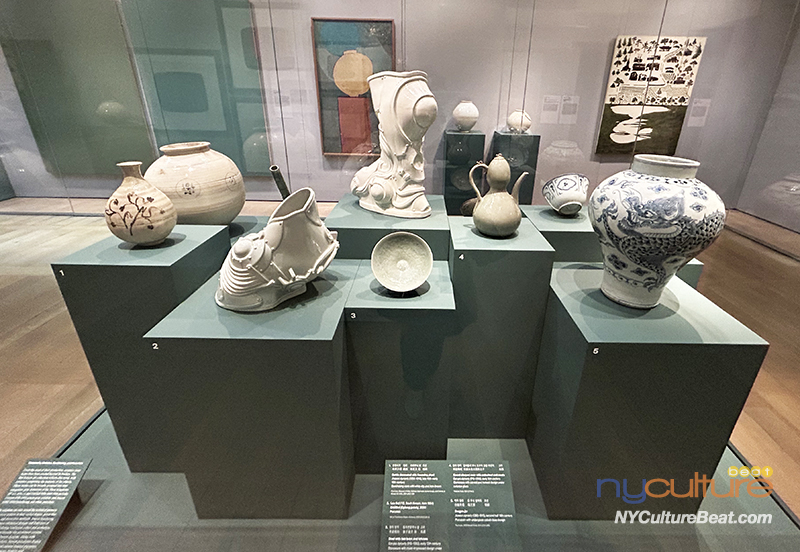
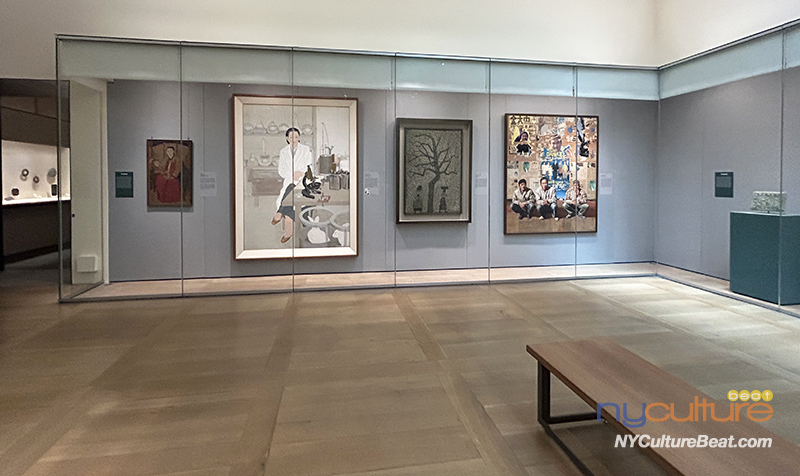
Lineages: Korean Art at The Met. Photo: Sukie Park/NYCultureBeat
마지막 주제는 ‘사람’이다. 20세기 이전, 서예와 산수화는 존중받는 회화의 양식이었으며, 인물 표현은 대개 초상화에서 사용되었다. 박수근이 그린 고요하지만 꿋꿋한 여인들부터 이종구의 뜻 모를 표정의 남성들까지, 인물 표현의 유형과 방식의 확장은 20세기 한국 사회가 경험한 계급제의 재편 및 급격하면서도 또한 총체적인 사회 변화를 반영한다.
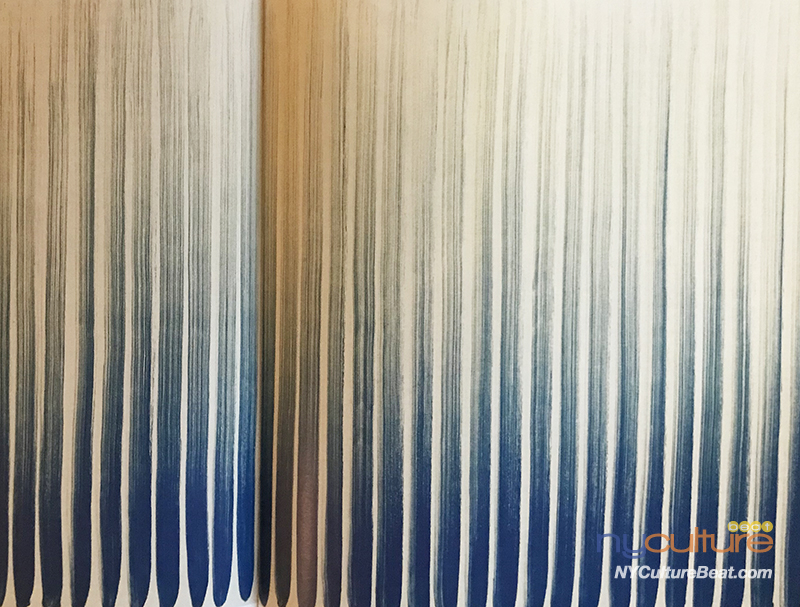
이우환, 선에서, 1979. 리움미술관 소장
전시 작품 중 다수는 하나 이상의 주제에 속한다. 따라서 각 대상과 그 형식적, 재료상의 특성을 강조함으로써, Lineages: Korean Art at The Met 전시는 한국 미술의 이야기가 단순한 이분법을 넘어서 엄격한 범주화에 도전하는 작가의 노력을 전달하고 다원화 유지의 중요성을 부각시킨다. 각 작품은 표현 양식이 지속되는가, 도전을 받는가, 재창조 되는가를 고려하여 분류된다.
Exhibition at The Met Celebrates 25th Anniversary of Arts of Korea Gallery
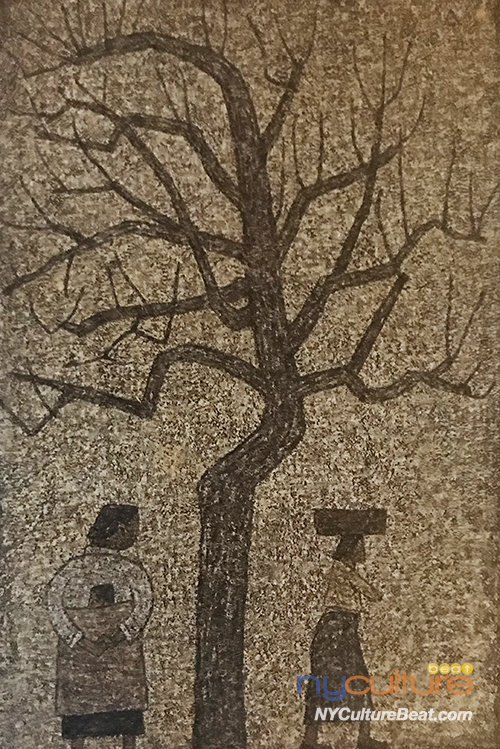
박수근, 나무와 두 여인, 1965. 리움미술관 소장
(New York, October 12, 2023)—On November 7, 2023, The Metropolitan Museum of Art will present the exhibition Lineages: Korean Art at The Met, which celebrates the 25th anniversary of the opening of the Museum’s Arts of Korea gallery. The exhibition will showcase 30 objects dating from the 12th century to the present day, including works acquired by the Museum in the last 25 years, paired with important international loans of 20th-century art. Some of the objects will rotate during the run of the exhibition. Through four themes—lines, things, places, and people—the exhibition will display the history of Korean art in broad strokes. The exhibition is made possible by the Ministry of Culture, Sports and Tourism of the Republic of Korea (MCST).
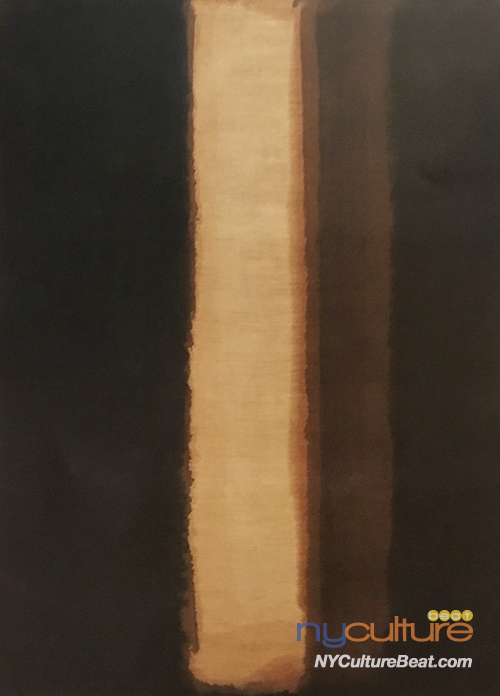
윤형군, 청다, 1975. 국립현대미술관 소장
The first works of Korean art to enter The Met collection were eight musical instruments—part of the monumental gift of the Crosby Brown Collection in 1889. Four years later, in 1893, a mid-15th-century buncheong dish decorated with stamp-impressed chrysanthemums and dots in white slip was acquired by the Museum through a gift of 245 Asian ceramics from the Hudson River School painter Samuel Colman and his wife, Ann Lawrence Colman (née Dunham). The Met’s collection of Korean art grew steadily with the addition of some of the rarest objects, such as a 12th-century inlaid lacquer box and five prized Goryeo-dynasty (918–1392) Buddhist paintings, acquired between 1913 and 1930.
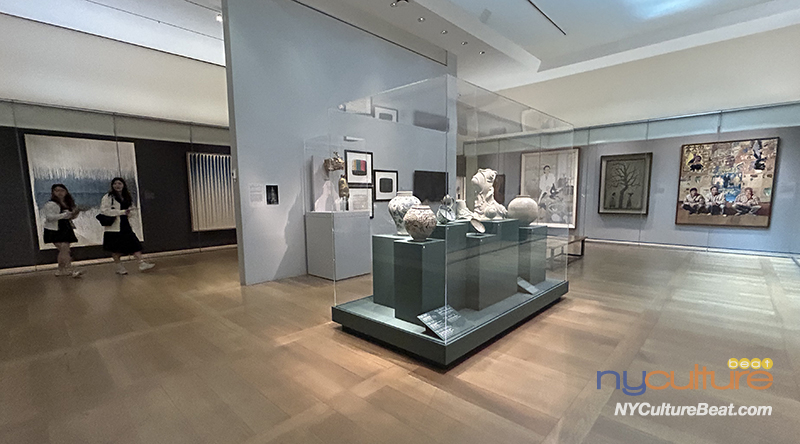
Lineages: Korean Art at The Met. Photo: Sukie Park/NYCultureBeat
The Met signaled its commitment to the study of Korean art with the establishment of its first permanent gallery dedicated to the subject in 1998. New art forms and topics, such as buncheong, the Diamond Mountains, and the Silla dynasty (57 BCE–935 CE) were introduced to a global audience through pioneering exhibitions and publications.
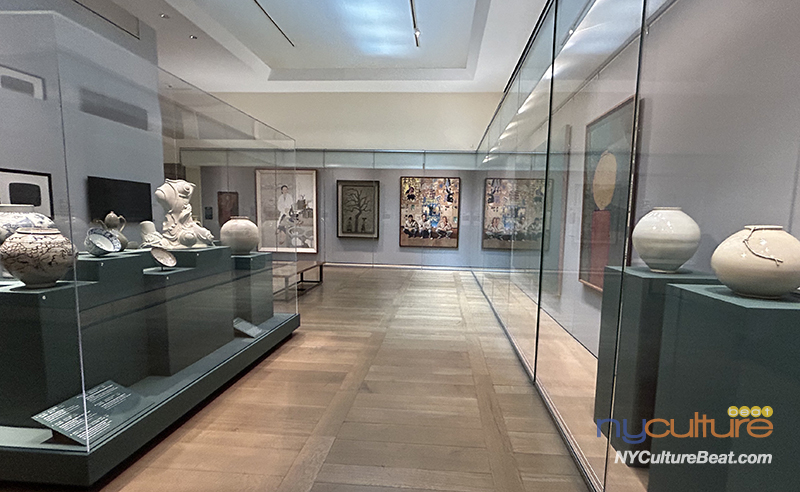
Lineages: Korean Art at The Met. Photo: Sukie Park/NYCultureBeat
Eleanor Soo-ah Hyun, Korea Foundation and Samsung Foundation of Culture Associate Curator of Korean Art at The Met, said: “The significance of the Arts of Korea gallery cannot be overstated. The gallery provides a platform not only to showcase Korean art through groundbreaking exhibitions but also to develop and increase the presence of Korean art and culture in The Met through acquisitions and public programming. In featuring modern Korean art in this exhibition, The Met is highlighting areas to develop and future pathways to pursue.”
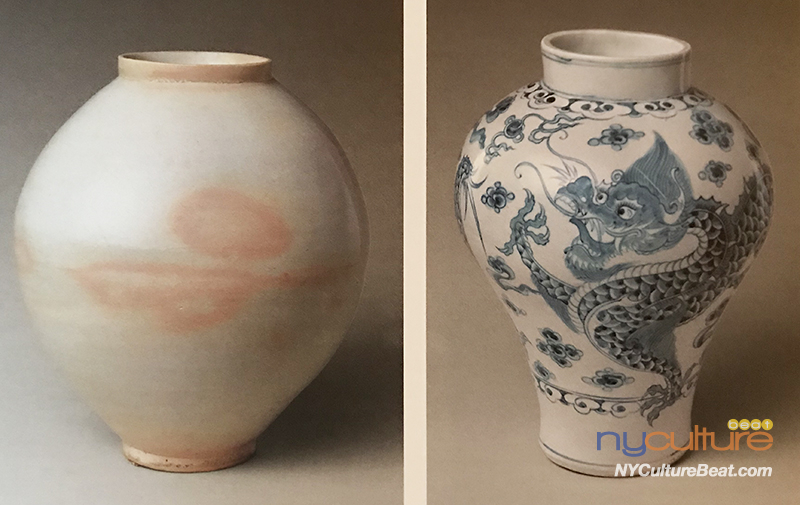
달항아리, 18세기 후반/ 청화백자 용문 항아리, 18세기 후반. 메트로폴리탄뮤지엄 소장
Exhibition Overview
Lineages: Korean Art at The Met opens with the ink painting People by Suh Se Ok (1929–2020). A complex image formed by repeating the character for “human,” People is a captivating landscape of many people that encapsulates the exhibition’s four intertwined thematic sections: Lines, Things, Places, and People. The first theme, Lines, traces the importance of calligraphy and ink painting in Korean art and the multiple and divergent responses of modern artists to its significance and legacies.
The exhibition continues with Things, which examines the connection between historical and contemporary Korean art through objects. Historically, Korean ceramics have received the greatest attention in the West and comprise the bulk of collections in most Western museums. The Korean collection at The Met follows this trend. In this theme, ceramics are paired with modern and contemporary works—ranging from Kim Whanki’s Moon and Jar to Byron Kim’s Goryeo Green Glaze #1 and Goryeo Green Glaze #2—which look to earlier art forms to draw inspiration from, as well as to question, artistic conventions.
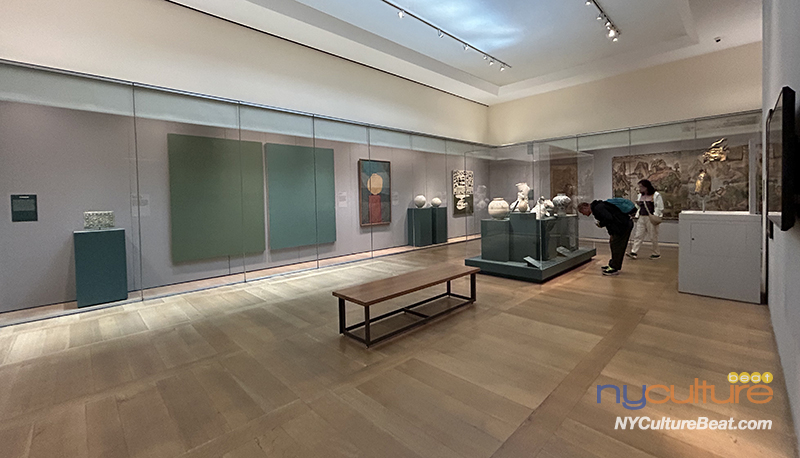
Lineages: Korean Art at The Met. Photo: Sukie Park/NYCultureBeat
The formation of lineages and histories cannot be separated from Places, the exhibition’s third theme. Place has long been deeply engrained in Korean art, notably in landscapes, with ties to notions of belonging, homeland, and identity. In the 20th century, with colonization and then the division of the peninsula, these notions about place take on additional implications of rupture, displacement, and separation, and these complexities can be seen in the works of Paik Nam-soon and Kim Hong Joo.
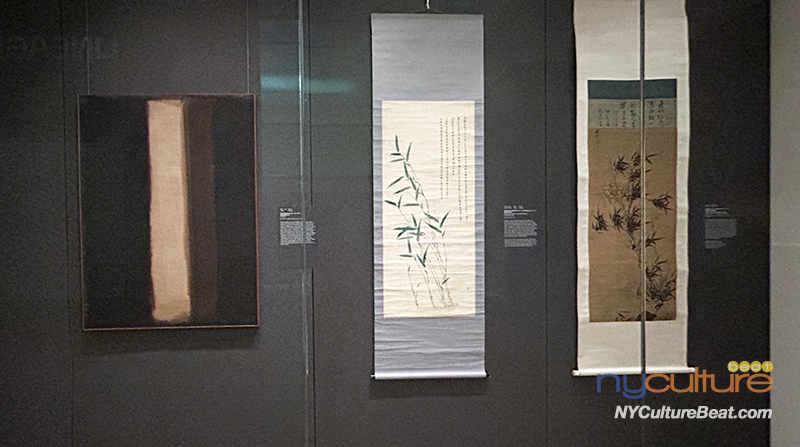
Lineages: Korean Art at The Met. Photo: Sukie Park/NYCultureBeat
The last theme is People. Prior to the 20th century, calligraphy and landscape were the revered modes of painting, and figural representation was predominantly in the form of portraiture. From the muted but intransient women by Park Soo-keun, to the inscrutable male laborers by Lee Jong-gu, the expansion in the types of and manner in which people are depicted reflect the reconfiguration of the class system and the rapid comprehensive societal change that Korea experienced in the 20th century.
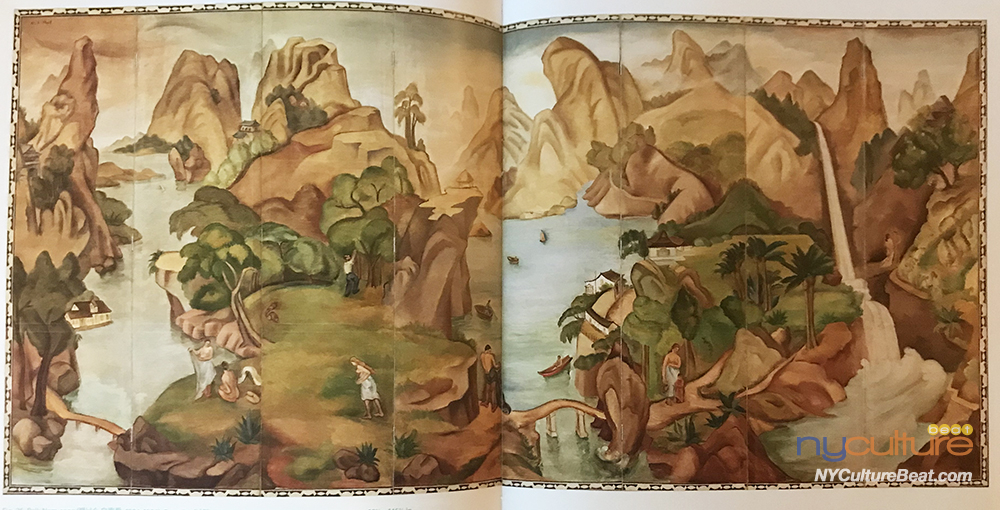
백남순, 낙원, 1936. 국립현대미술관 소장 이건희컬렉션
Many of the works in the exhibition could be sorted into more than one thematic section; thus by emphasizing each object and its formal and material characteristics, Lineages: Korean Art at The Met shifts the story of Korean art beyond simple binaries, echoes the artists’ efforts against strict categorizations, and foregrounds the importance of retaining plurality. The objects are deliberately grouped into loose constellations in order to consider the manner in which stylistic lineages are continued, challenged, or reshaped.
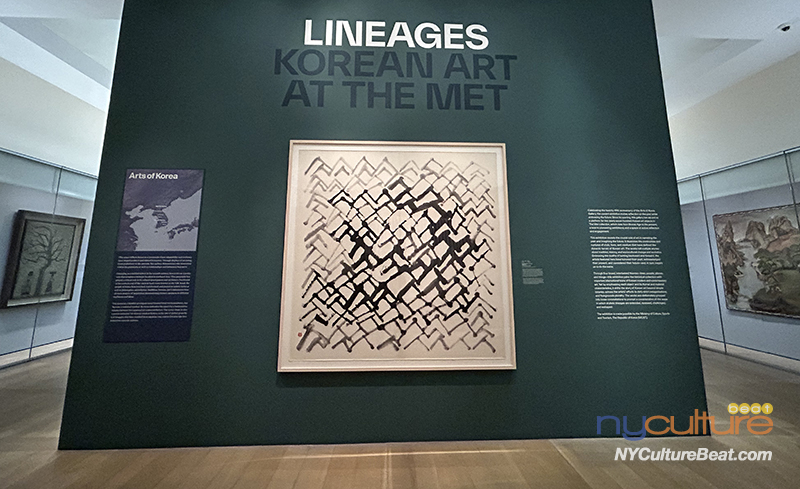
Lineages: Korean Art at The Met. Photo: Sukie Park/NYCultureBeat




 강익중 작가 주스페인 한국문화원 개인전 '내가 아는 것(Lo que s...
강익중 작가 주스페인 한국문화원 개인전 '내가 아는 것(Lo que s...
 야요이 쿠사마(Yayoi Kusama) 자서전에 흑인혐오 묘사 사과
야요이 쿠사마(Yayoi Kusama) 자서전에 흑인혐오 묘사 사과


김환기 이우환 박수근등 이미 관록을 쌓은 유명 작가들의 작품들을 메트뮤지엄에서 전시하다니 꿈만 같습니다.
특히 박수근 화가의 그림을 좋아해서 개인 소장품과 지방의 작은 전시회를 통해 봤습니다. 가난하던 시절의 한국여인들의 모습을 실감나게 그려서 감탄을 했습니다. '빨래터'는 깊이 머리에 와닿아서 마음에 간직하고 있지요. 가난을 예술로 승화시킨 50년대 60년대 화가들이 위대할 뿐입니다.
-Elaine-